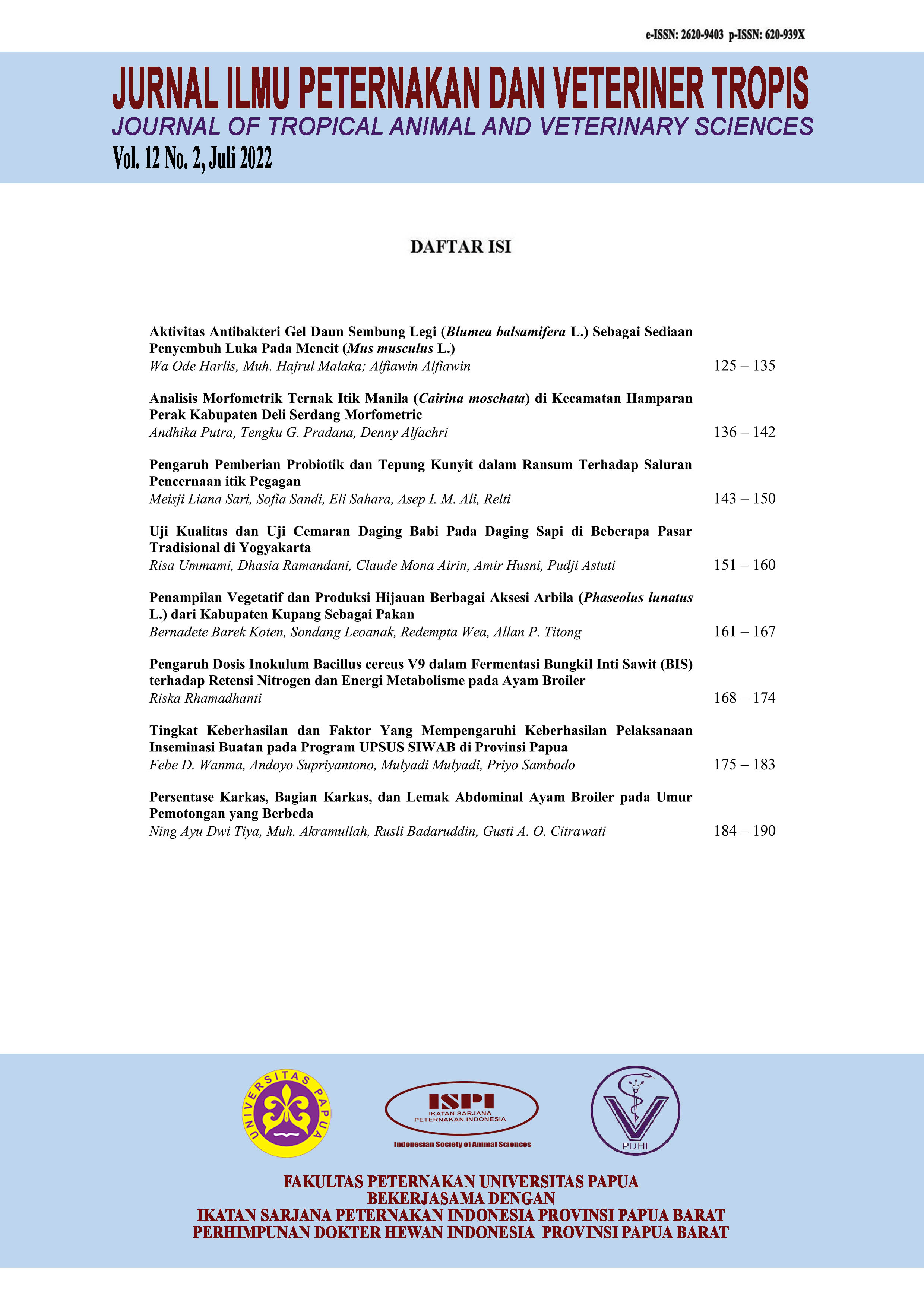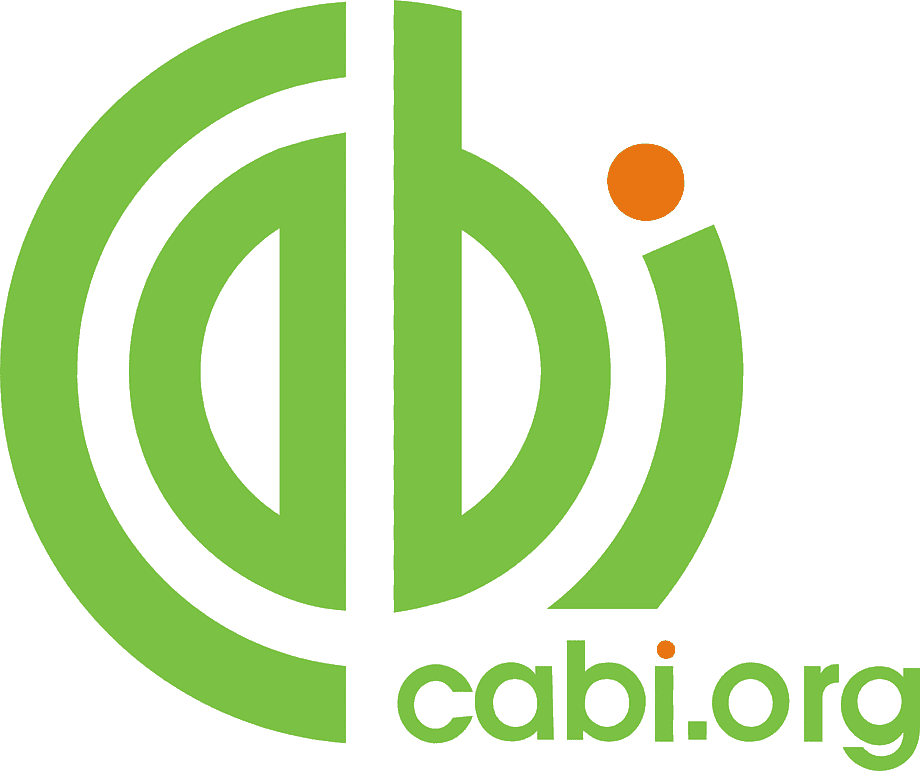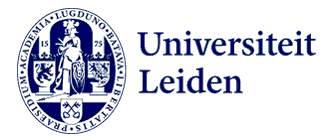Pengaruh Dosis Inokulum Bacillus cereus V9 dalam Fermentasi Bungkil Inti Sawit (BIS) terhadap Retensi Nitrogen dan Energi Metabolisme pada Ayam Broiler
The Effect of Bacillus cereus V9 Inoculum Dosage in the Fermentation of Palm Kernel Cake on Nitrogen Retention and Metabolism Energy in Broiler Chicken
DOI:
https://doi.org/10.46549/jipvet.v12i2.222Keywords:
Bacillus cereus ; Fermentation; Palm kernel cake;Abstract
Abstract
The use of palm kernel cake as poultry feed can be increased, so the limiting factor in the form of crude fiber content can be reduced through fermentation. This study aims to determine the metabolic energy content and nitrogen retention of this palm kernel cake fermented with Bacillus cereus V9. This study used 18 broiler chickens aged 35 days with a weight of ±1.5 kg. The research design used was a completely randomized design consisting of 4 treatments and 4 replications. The treatments given were the dose of Bacillus cereus V9 inoculum in the fermentation of palm kernel cake, namely P1 (0%), P2 (5%); P3 (10%); P4 (15%). The observed variables were nitrogen retention, pseudo metabolic energy, pure metabolic energy, nitrogen corrected pseudo metabolic energy, nitrogen corrected pure metabolic energy.The results showed that the administration of Bacillus cereus V9 inoculum in the fermentation of palm kernel cake significantly affected nitrogen retention, pseudo and pure metabolic energy content in broiler chickens. The administration of Bacillus cereus V9 inoculum as much as 10% in the fermentation of palm kernel meal showed a higher nitrogen retention value and metabolic energy than the administration of 5 and 15% inoculum. Based on the results of the study, it can be concluded that an inoculum dose of 10% Bacillus cereus V9 can be given in the fermentation of palm kernel cake to increase nitrogen retention and metabolic energy content in broiler chickens.
Keywords: Bacillus cereus; Fermentation; Palm kernel cake
Abstrak
Pemanfaatan BIS sebagai pakan unggas dapat ditingkatkan, maka faktor pembatas berupa kandungan serat kasar harus dikurangi jumlahnya dan salah satunya adalah melalui fermentasi. Penelitian ini bertujuan untuk mengetahui kandungan energi metabolisme dan retensi nitrogen dari BIS yang di fermentasi dengan Bacillus cereus V9. Penelitian ini menggunakan 18 ekor ayam broiler umur 35 hari dengan bobot ±1,5 Kg. Rancangan penelitian yang digunakan adalah rancangan acak lengkap yang terdiri dari 4 perlakuan dan 4 ulangan. Perlakuan yang diberikan adalah dosis pemberian inokulum Bacillus cereus V9 dalam fermentasi BIS yaitu P1 (0%); P2 (5%); P3 (10%); P4 (15%). Pengubah yang diamati yaitu retensi nitrogen, energi metabolisme semu, energi metabolisme murni, energi metabolisme semu terkoreksi nitrogen, energi metabolisme murni terkoreksi nitrogen. Hasil penelitian menunjukkan bahwa pemberian inokulum Bacillus cereus V9 dalam fermentasi BIS berpengaruh nyata terhadap retensi nitrogen, kandungan energi metabolisme semu dan murni pada ayam broiler. Pemberian inokulum Bacillus cereus V9 sebanyak 10 % dalam fermentasi BIS menunjukkan nilai retensi nitrogen dan energi metabolis yang lebih tinggi dari pemberian inokulum 5 dan 15 %. Berdasarkan hasil penelitian dapat disimpulkan bahwa dosis inokulum Bacillus cereus V9 sebesar 10% dapat diberikan dalam fermentasi BIS untuk meningkatkan retensi nitrogen dan kandungan energi metabolism pada ayam broiler.
Kata kunci: Bacillus cereus; Bungkil Inti Sawit; Fermentasi
Downloads
References
Arneti A. 2016. “Aktivitas ekstrak heksan tumbuhan patah tulang Euphorbia tirucalli (Euphorbiaceace) terhadap telur Crocidolomia pavonana (Lepidoptera: Crambidae),” in. doi: 10.13057/psnmbi/m020101.
Bahri RS. 2008. Evaluasi energi metabolis pakan lokal pada ayam petelur. Fakultas Pertanian. Universitas Tadulako. Palu. J. Argolan 15(1): 75-78.
Dusterhoft EM, Bonte AW and Voragen AGJ. 1993. Solubilisation of non-starch polysaccharides from oil seed meals by polysacharide degrading enzymes. Journal of the Science Food and Agriculture, 63: 211-220.
Elvina D. 2008. Nilai Energi Metabolis Ransum Ayam Broiler Berbasis Pollard yang ditambahkan Enzim Xilanase dan Diproses dengan Mesin Pelleter. Skripsi Fakultas Peternakan Institut Pertanian Bogor, Bogor.
Fardiaz S. 1988. Mikrobiologi Pangan. Depdikbud, Dirjen Dikti. PAU Pangan dan Gizi IPB, Bogor.
Ibrahim W, Mutia R and Nurhayati. 2015. Use of fermented pineapple peel in the ration containing medicinal weeds on fat and cholesterol of broiler chicken. Agripet : Vol (14) : 20-27.
Iskandar S, Sinurat AP, Trisnamurti dan Bamualim A. 2008. Bungkil sawit potensial untuk pakan ternak. Warta Penelitian dan Pengembangan Pertanian. 30: 16-17.
Mairizal. 2018. Potensi Bakteri Asal Saluran Pencernaan sebagai Agensi Probiotik dan Enzim Mannanase untuk Menghidrolisis BIS dan Aplikasi dalam Ransum Broiler. Disertasi. Program Doktor Ilmu Peternakan, Fakultas Peternakan, Universitas Andalas Padang, Padang.
Mangisah I, Suthama ND, Yunianto VD dan Hastuti D. 2008. Pengaruh berbagai level serat kasar dalam ransum terhadap retensi nitrogen dan masa protein daging. Buletin Peternakan. 32 (2): 78-84.
Maynard LA, Loosil JK, Hintz HF dan Warner RG. 2005. Animal Nutrition. 7th Ed McGraw-Hill Book Company. New York, USA.
McDonald P, Edwards RA, Greenhalgh JFD, Morgan CA, Sinclair LA and Wilkinson RG. 2010. Animal Nutrition. 7th Ed. Prentice Hall, Pearson, Harlow, England, London and New York.
Nastiti, UN., Lastuti and NDR., Nurhajato. 2013. The decreasing of crude fiber and the increasing of crude ptotein content of pineapple (Ananas comosus L, Merr) which fermented by cellulolytic bacteria (Actinobacillus sp. ML-08). Jurnal Agroveteriner. 1 (2) : 46–54.
National Research Council. 1994. Nutrient Requirement of Poultry. 9th Revised Ed. National Academy Press, Washington D. C.
Purwati CS dan Windyasmara L. 2019. “Fermentasi biji kecipir (Psophocarpus tetragonolobus) oleh jamur trichoderma viride terhadap warna, tekstur, dan serat kasar,” Jurnal Ilmu Peternakan dan Veteriner Tropis (Journal of Tropical Animal and Veterinary Science), 9(1), hal. 1. doi: 10.30862/jipvet.v9i1.2.
Santoso B, Kilmaskossu A dan Sambodo P. 2007. “Effects of saponin from Biophytum petersianum Klotzsch on ruminal fermentation, microbial protein synthesis and nitrogen utilization in goats,” Animal Feed Science and Technology, 137(1–2), hal. 58–68. doi: 10.1016/j.anifeedsci.2006.10.005.
Sembiring P. 2009. Peningkatan kecernaan protein dan energi metabolisme BIS fermentasi pada ayam broiler. Seminar Nasional Teknologi Peternakan dan Veteriner, 626- 632.
Sibbald IR. 1981. Metabolic plus endogenous energy and nitrogen losses of adult cockerels : the corretion used in bioassay for true metabolizable nergy. International Development Reseach Center. Canada.
Sibbald IR and Wolynetz MS. 1985. Relationship between estimates of bioavailable energy made with adult cockrerels and chicks: Effect of feed intake and nitrogen retention. J. Poultry. Sci., 64: 127-138.
Sibbald IR and Wolynetz MS. 1986. Comparison of three methods of excreta collection used in estimation and nitrogen excretion. Poultry Sci. 65:78-84.
Sinurat AP, Purwadaria T, Pasaribu T, Ketaren P, Hamid H, Emmi E, Fredick, Udjianto, Haryono. 2009. Proses Pengolahan BIS dan Evaluasi Biologis Pada Ayam. Laporan Penelitian. Bogor (ID): Balai Penelitian Ternak.
Steel RGD and Torrie JH. 1991. Prinsip dan Prosedur Statistika : Suatu Pendekatan Biometrik. Penerjemah Bambang S. Edisi ke-2. Jakarta : PT. Gramedia Pustaka Utama.
Sukmawati R. 2015. Pengaruh Lama Inkubasi terhadap Kandungan Energi Metabolisme BIS yang Difermentasi dengan Trichoderma harzianum dan Aspergillus niger. Skripsi. Fakultas Peternakan Universitas Jambi, Jambi.
Tafsin M. 2007. Polisakarida Mengandung Mangan dari BIS Sebagai Anti Mikroba Salmonella Thypimurium Pada Ayam. Media. Peternakan 30 : 139- 146.
Taylor MA, Coop RL dan Wall RL. 2015. “Veterinary Helminthology,” in Veterinary Parasitology. Hoboken, NJ, USA: John Wiley & Sons, Inc., hal. 1–109. doi: 10.1002/9781119073680.ch1.
Tillman AD, Hartadi H, Prawirokoesoemo S, Reksohadiprodjo S dan Lebdosoekojo. 1998. Ilmu Makanan Ternak Dasar. Gadjah Mada University Press, Yogyakarta.
Wahyu J. 2004 Ilmu Nutrisi Unggas. Gadjah Mada University Press. Yogyakarta.
Wahju J. 1997. Ilmu Nutrisi Unggas. Edisi ke-4. Gadjah Mada University Press. Yogyakarta.
Wibawa AAP, Wirawan IW dan Partama IBG. 2015. Peningkatan nilai nutrisi dedak padi sebagai pakan itik melalui biofermentasi dengan khamir. Majalah Ilmiah Peternakan 18(1):11-16.
Widjastuti T, Abun MP, Wiwin T, Indrawati YA. 2007. Pengolahan BIS melalui fermentasi oleh jamur Marasmius sp guna menunjang bahan pakan alternatif untuk ransum ayam broiler. Makalah ilmiah. Univ Padjajaran.
Downloads
Published
How to Cite
Issue
Section
License
Copyright (c) 2022 Riska Rhamadhanti

This work is licensed under a Creative Commons Attribution-NonCommercial-ShareAlike 4.0 International License.
License and Copyright Agreement
In submitting the manuscript to the journal, the authors certify that:
- They are authorized by their co-authors to enter into these arrangements.
- The work described has not been formally published before, except in the form of an abstract or as part of a published lecture, review, thesis, or overlay journal. Please also carefully read Jurnal Ilmu Peternakan dan Veteriner Tropis (Journal of Tropical Animal and Veterinary Science) Posting Your Article Policy at https://journal.fapetunipa.ac.id/index.php/JIPVET/publicationethics
- That it is not under consideration for publication elsewhere,
- That its publication has been approved by all the author(s) and by the responsible authorities “tacitly or explicitly“ of the institutes where the work has been carried out.
- They secure the right to reproduce any material that has already been published or copyrighted elsewhere.
- They agree to the following license and copyright agreement.
Copyright
Authors who publish with Jurnal Ilmu Peternakan dan Veteriner Tropis (Journal of Tropical Animal and Veterinary Science) agree to the following terms:
- Authors retain copyright and grant the journal right of first publication with the work simultaneously licensed under a Creative Commons Attribution License (CC BY-NC-SA 4.0) that allows others to share the work with an acknowledgment of the work's authorship and initial publication in this journal.
- Authors are able to enter into separate, additional contractual arrangements for the non-exclusive distribution of the journal's published version of the work (e.g., post it to an institutional repository or publish it in a book), with an acknowledgment of its initial publication in this journal.
- Authors are permitted and encouraged to post their work online (e.g., in institutional repositories or on their website) prior to and during the submission process, as it can lead to productive exchanges, as well as earlier and greater citation of published work.

This work is licensed under a Creative Commons Attribution-NonCommercial-ShareAlike 4.0 International License.





























.png)
